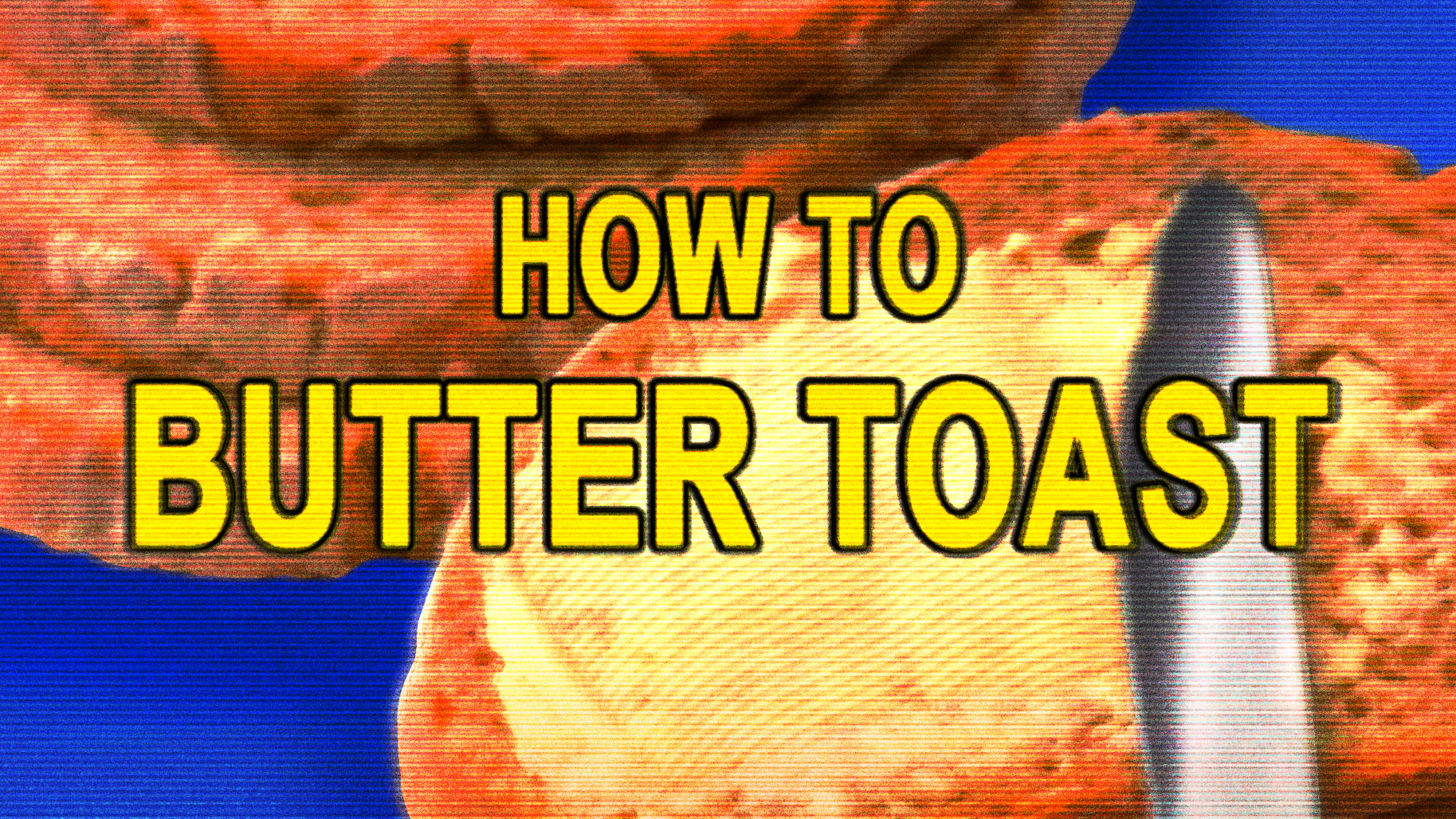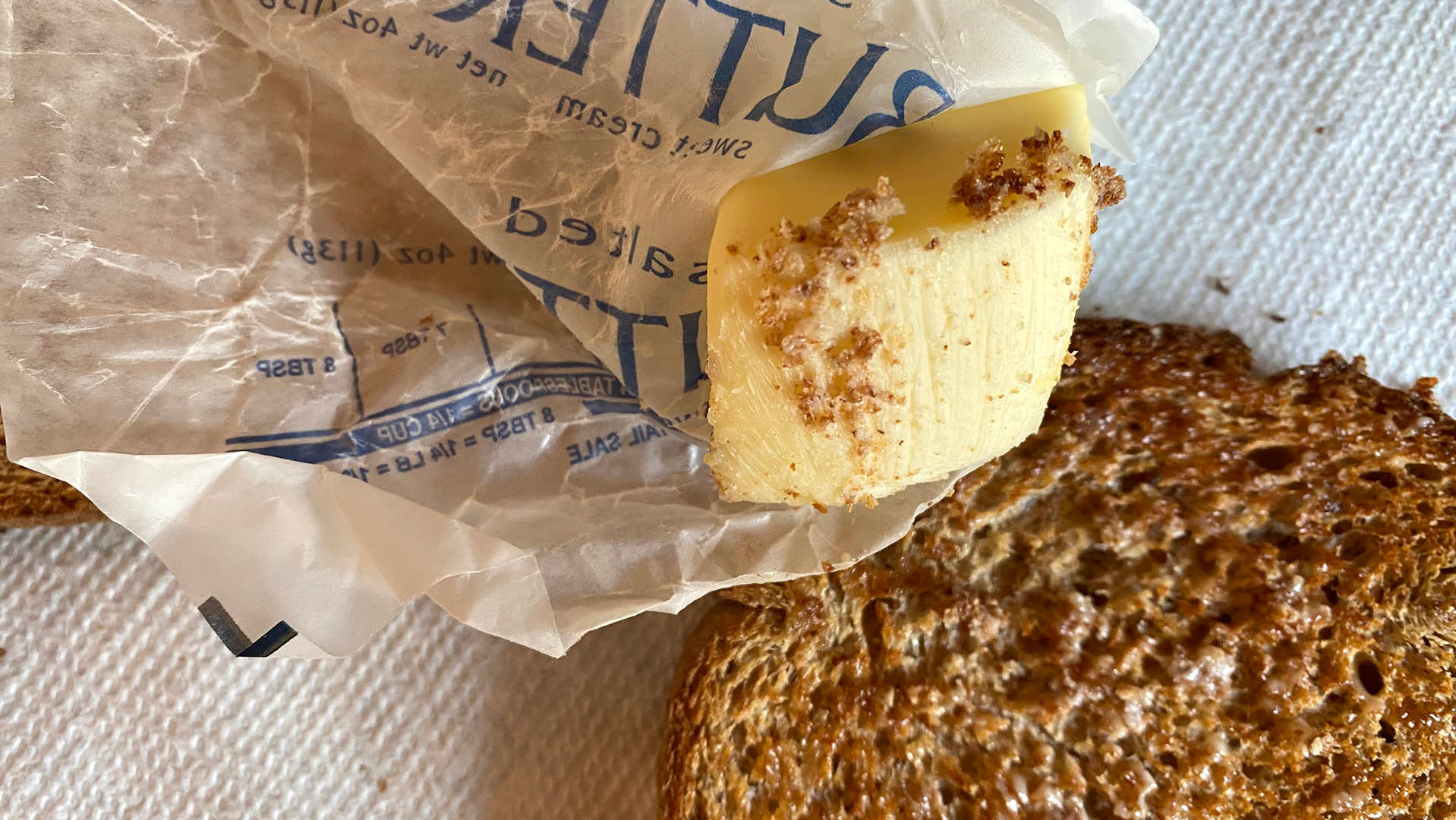Stick It: The Best Way To Butter Toast
Before anyone has a meltdown, let me start by saying that I'm not going to "blow your mind" with a new "life hack" about the proper way to butter toast. I didn't "discover" something that people have been doing for three decades. I have no video footage of a capuchin monkey using butter in a manner that never once occurred to millions of humans over thousands of years.
I merely wish to recount that in a recent fit of laziness, I remembered how we buttered toast growing up, a method taught to us by my dad. Once the toast pops up from the toaster, take your standard stick of butter and apply it directly to warm bread.
Genius!
Well, not exactly. It, like most methods, has its drawbacks. But it got me thinking. What is the best way to butter toast? There was only one way to find out: Rigorous scientific experimentation, by which I mean making toast and applying butter. Below is a ranking of the methods I tried, from worst to best.

Knife + butter + bread
Get outta here with that nonsense. Sure, it seems like the most logical way to apply butter—or anything—to a slice of bread. It's how you spread everything else—peanut butter, jelly, mayo, mustard, Miracle Whip (you sick bastard). So why not butter? I'll tell you why. The minute you try to drag that cold butter across the toast, your bread is in shreds. And what's crazy is that you try this repeatedly expecting different results.
The five-star method
This isn't a testament to favorable online reviews of this approach, but rather a description. This one only works for those of you fancy enough to own toaster ovens. Slice off five thin pats of butter. Place one in each corner of your untoasted bread and one in the middle. Then toast. I was excited about this method at first: I am 46 years old and had never heard of it. And it works! Kind of. There's a good chance butter might drip onto the crumb pan of your toaster oven (or worse, onto one of the burners). And the bottom of your toast is going to get crispy well before the buttered portion if you don't fiddle around with the settings.
In other words, it's not what you want from the toast experience. It's more of a a high-maintenance method with a chance of smoking up the house. Don't even get me started on messing with toaster oven settings. You do something that foolish, then next thing you know, you're standing there waiting 15 minutes for your bread to toast because some idiot (you) previously dropped the temperature down to 200 and turned the toast knob to bake. Entirely too much drama before your coffee in the morning.
The pat preheat
Slice your butter pats ahead of time and let them sit. Then use the knife method. But really, that takes a little more advance planning than many toast eaters are interested in. If you slice the pats immediately before toasting begins, they won't be soft by spreading time. If by some miracle you remember to do this well in advance, they'll get too soft and stick to whatever you put them in, and also to the knife. So not only do you have to dirty at least one extra dish, you have to get your fingers involved.
Stick it to ’em
This is the childhood method that I rediscovered during my fit of laziness. And this is definitely the lazy person's ideal buttering process. It involves no dishes at all. Not even a knife. Simply take your stick of butter and hold it like a writing implement. Use a coloring motion to cover the entire toast. It's simple, effective, and gives you pretty good coverage. But you get only a thin layer of butter before the toast loses the heat necessary to melt the stick. The other drawback is that you now have a stick of butter with unsightly toast crumbs all over the end of it. Which apparently is a huge issue for other people in the house, even if those other people only use the butter once in a blue moon.
The Euro thrash
The best thing about writing this piece is that I can imagine a substantial portion of readers just losing their minds while reading it: "Why are you using cold butter on your toast, you absolute dumbass!?!?" Or "750 words and not one of them acknowledging the stupid American insistence on refrigerating butter until it's a rock-hard brick!?!?" These unpatriotic America-hating people are 100% right to be outraged. Butter does not have to be refrigerated. Now try telling that to Americans who love their technology, are bad at science, and good at paranoia.
But seriously. Leave a stick of butter out on the counter in a butter dish. Just one. If your spouse is convinced you'll die of food poisoning, botulism, salmonella, or Vague Dairy Disease, point out that there are three more sticks of toast-tearing butter in the refrigerator.
Has your butter been out on the counter? Good. Now please refer to the first—and worst—item on this list. Try it with your room-temperature butter. Just knife off a hunk of it, glop it on to your toast, and go nuts. Want a little? Then use a little. But c'mon. We're buttering toast here. And now that you have soft, pliable, spreadable, golden goodness, it's no time to be conservative. Pile it on. Let one layer melt into the toast and then throw another layer on top. Butter it until you can't even see the toast anymore.
That, my friends, is the best way to butter toast. Unrefrigerated butter and a knife. Save all that cold butter for making biscuits and pie dough.

